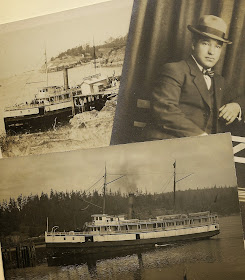 |
Date, ferry, location, master, all unknown.
We do know it is an original photo by Aashel Curtis.
From the archives of the S. P. H. S.
Click to enlarge. |
This is the time of the year when folks start getting acquainted with the Puget Sound ferry captains. Whether you are a daily commuter to Vashon or Bainbridge Islands, the Kitsap County mainland, or a passenger on the longer ferry trips on Puget Sound, it's worthwhile to know who is the captain of the boat on which you are riding
 |
Capt. Louis Van Bogaert with unknown passenger
|
to many Seattleites, the Sound skippers need no introduction. They're institutions. Take Capt. Wallace Mangan of the ferry CHIPPEWA, for instance. He's been on the Seattle-Bremerton route for 22 years and his alternate, Capt. Thomas Sumner has been a Sound skipper for Puget Sound Navigation Co for 14 years.
 |
S. S. IROQUOIS Menu
with Captain L. Van Bogaert listed as skipper, 1938.
From the archives of the S. P. H. S.©
|
Among the Black Ball Line few skippers have a better record than Capt. Louis Van Bogaert of the IROQUOIS that runs between Seattle and Victoria, BC, via Port Angeles. Capt. Van Bogaert has been with the company since 1904 and has often saved small craft in distress. [Capt. Louis, who was raised on Orcas Island, retired in 1957 after working on the water his whole career.]
Manchester commuters could be offended if Capt. James Anderson and Capt. George Clements, alternate on the ferry CROSLINE, were not mentioned while Capt. Lawrance Crowley of the ferry QUILLAYUTE running between Edmonds and Port Ludlow, has been on the Port Ludlow route since its establishment and has hundreds of friends on the Olympic Peninsula.
 |
Captain Clarence Lampman
Dated original stamped 14 August 1961.
From the archives of the Saltwater People Log© |
Other popular Sound skippers are: Captains Clarence Lampman and Lyle Fowler of the ferry SEATTLE, running between Bremerton and Seattle;
Capt. Ole Rindal of the ferry INDIANAPOLIS on the Edmonds-Port Townsend route; Capt. Walter Murry of the ferry AIRLINE on the Seabeck-Brinnon route; Capt. A. N. Draper of the SOL DUC on the Seattle-Kingston route; Capt. S. F. Hunsiker of the Mukilteo-Columbia Beach route; Capt. Oliver van Nieuwenhuise of the COMANCHE on the Straits route; Capt. John Oldow of the Gooseberry Point-Orcas Island route and Capt. Carl Stevens of the excursion steamer TACOMA.
The Kitsap Ferry Line, operating boats to Vashon, Bainbridge Island, Rolling Bay, and Poulsbo also has its familiar captains, many of whom are veteran Sound navigators like Capt. C. T. Wyatt, who alternates with Capt. Tom Birkland on the run to Port Blakeley. There's Capt. Ward Henshaw of the Str. WINSLOW that runs to Eagle Harbor points. And Capt. Arney Rodal of the MANITOU, which runs between Seattle and Rolling Bay points, not to overlook the popular Capt. Jim Shaw of the VASHON who keeps on schedule despite the fact that he has saved more than one man from missing the "last boat" by waiting a few minutes.
+rppcs.jpg) |
The highly regarded Captain Sam Barlow
and the ROSALIE
serving the San Juan Islands.
Three photos from the archives of the S. P. H. S.© |
No list of Sound skippers would be complete without mention of Capt. Sam Barlow of the ferry ROSARIO on the Anacortes-San Juan Islands route. The holder of one of the oldest master's licenses on Puget Sound, Capt. Barlow [born on Lopez Island] was an early captain on the old ROSALIE, one of the first Black Ball steamers.
Above text published by The Seattle Times, June 1933




+rppcs.jpg)


+here.jpg)




+pcs.jpg)




.jpg)
